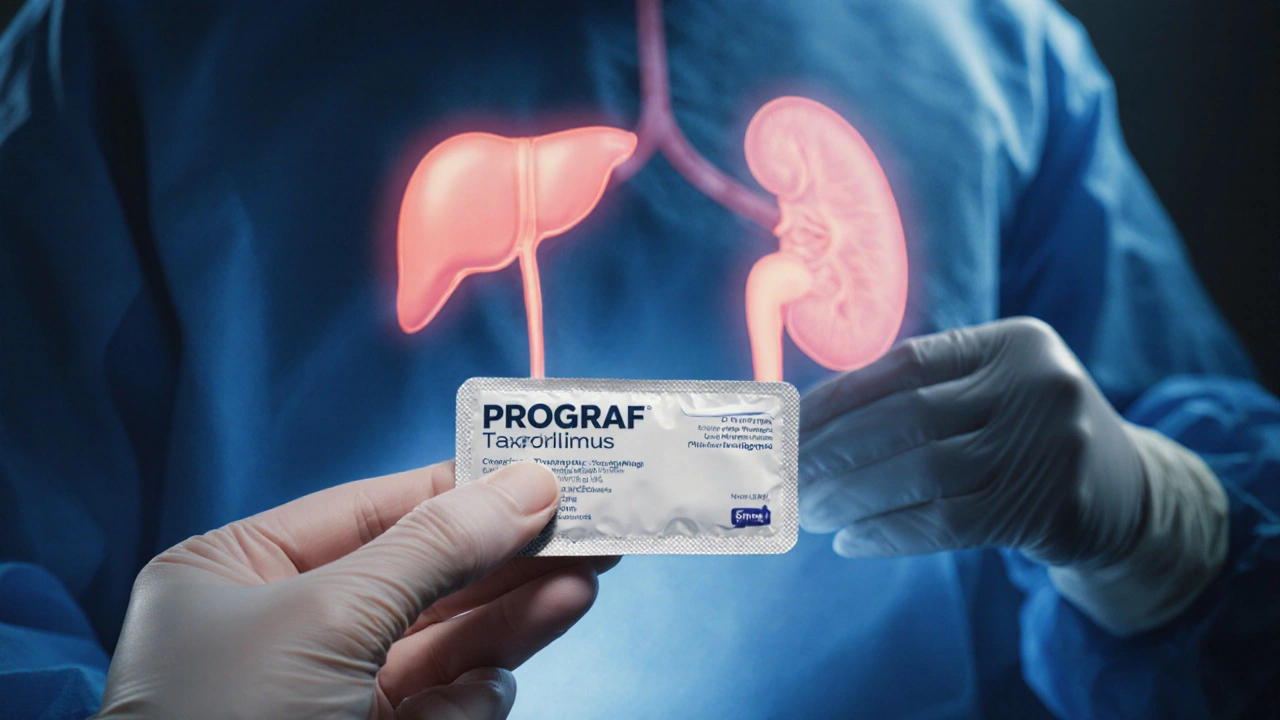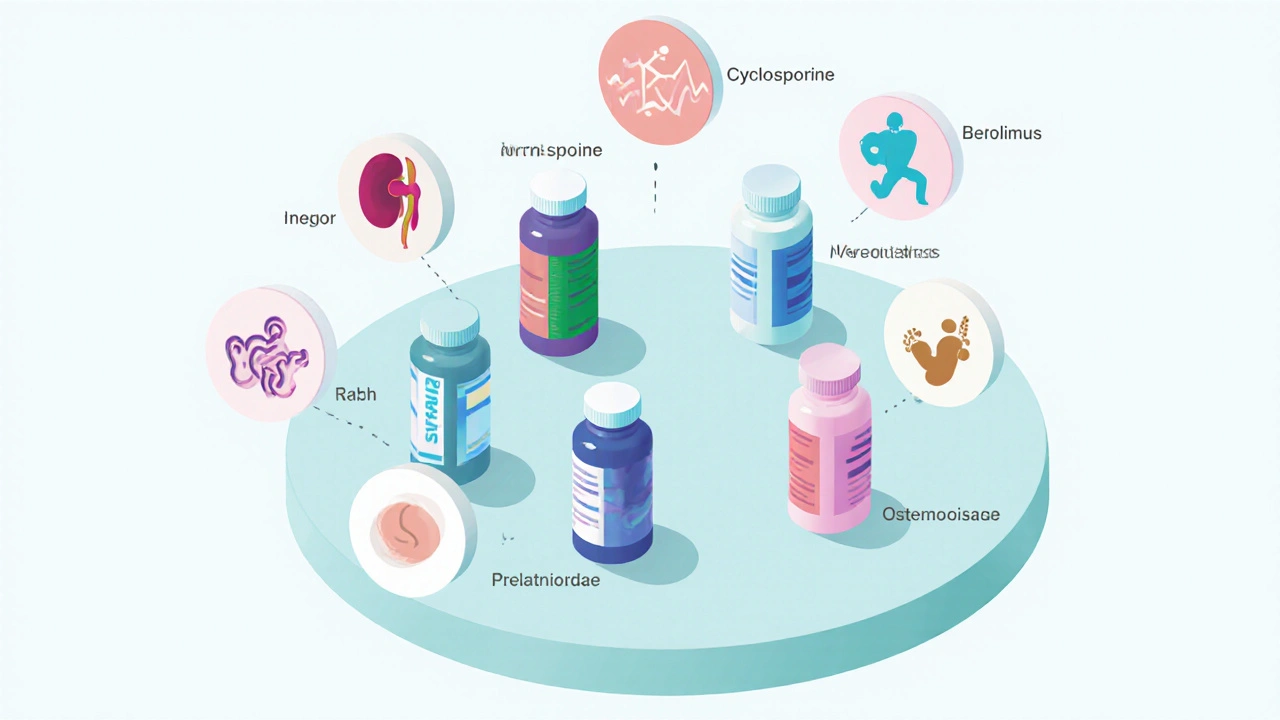
Prograf vs. Alternatives Comparison Tool
Compare key attributes of Prograf and its alternatives to help understand treatment options.
Prograf (Tacrolimus) Side Effects
Nephrotoxicity, tremor, high blood sugar, headache
Serious Risks: Acute kidney injury, infections, lymphoma (rare)
Quick Comparison Table
| Drug | Primary Use | Side Effect Profile | Cost Range (Monthly) |
|---|---|---|---|
| Prograf | Kidney, liver, heart, lung transplants | Nephrotoxicity, tremor, high blood sugar | $1,200-$1,500 |
| Cyclosporine | Heart, liver transplants | Gum hyperplasia, hirsutism, high cholesterol | $80-$150 |
| Sirolimus | Kidney, liver transplants | Delayed wound healing, mouth ulcers | $200-$300 |
| Everolimus | Kidney, liver transplants | Stomatitis, rash, hyperlipidemia | $400-$600 |
| Mycophenolate Mofetil | Prevents organ rejection | Diarrhea, nausea, anemia | $120-$250 |
| Belatacept | Kidney transplants | Infusion reactions, headache | $2,000-$3,000 |
| Prednisone | Reduces inflammation and immune activity | Weight gain, mood swings, osteoporosis | $10-$20 |
When you or a loved one need a drug to keep a transplanted organ from being rejected, Prograf is the brand name you’ll hear most often. Prograf (generic name tacrolimus) is a calcineurin inhibitor that suppresses the immune system, reducing the chance that the body attacks a new kidney, liver, heart, or lung graft. But it isn’t the only option on the market, and the right choice depends on factors like side‑effect tolerance, dosing convenience, and cost. This guide walks you through the most common alternatives, shows how they stack up, and gives you a checklist to decide what fits your situation best.
How Prograf Works
Prograf blocks a protein called calcineurin inside T‑cells. When calcineurin can’t work, the T‑cells don’t release interleukin‑2, a signal that tells the immune system to attack. The end result is a calmer immune response, which is exactly what a transplant patient needs.
Typical dosing starts at 0.1mg/kg per day, split into two doses, and is adjusted based on blood level monitoring. The therapeutic window is narrow, so regular blood tests are a must.
Common Alternatives at a Glance
Below are the drugs that show up most often when doctors talk about “Tacrolimus alternatives.” Each has its own mechanism, dosing style, and side‑effect profile.
- Cyclosporine (another calcineurin inhibitor, launched in the 1980s, often used in heart and liver transplants.)
- Sirolimus (an mTOR inhibitor that blocks cell growth, useful for kidney and liver transplants.)
- Everolimus (a newer mTOR inhibitor with a shorter half‑life, approved for kidney and liver grafts.)
- Mycophenolate Mofetil (an anti‑proliferative agent that stops B‑ and T‑cell replication, often paired with calcineurin inhibitors.)
- Belatacept (a selective costimulation blocker given by IV infusion, mainly for kidney transplants.)
- Prednisone (a corticosteroid that reduces inflammation and immune activity, used in almost every transplant protocol.)

Side‑Effect Snapshot
All immunosuppressants come with trade‑offs. Here’s a quick look at the most common issues you might see with each drug.
| Drug | Typical Side‑Effects | Serious Risks |
|---|---|---|
| Prograf | Nephrotoxicity, tremor, high blood sugar, headache | Acute kidney injury, infections, lymphoma (rare) |
| Cyclosporine | Gum hyperplasia, hirsutism, high cholesterol | Nephrotoxicity (similar to Prograf), hypertension |
| Sirolimus | Delayed wound healing, mouth ulcers, high triglycerides | Proteinuria, increased infection risk |
| Everolimus | Stomatitis, rash, hyperlipidemia | Pulmonary toxicity, impaired wound healing |
| Mycophenolate Mofetil | Diarrhea, nausea, anemia | Bone marrow suppression, serious infections |
| Belatacept | Infusion reactions, headache | Post‑transplant lymphoproliferative disorder (PTLD) |
| Prednisone | Weight gain, mood swings, osteoporosis | Diabetes, hypertension, cataracts (long‑term) |
Cost Considerations (2025 Snapshot)
Price matters for many patients, especially those without full insurance coverage. Approximate monthly costs in the United States (average retail price) are:
- Prograf: $1,200-$1,500
- Generic tacrolimus (when available): $300-$500
- Cyclosporine (generic): $80-$150
- Sirolimus: $200-$300
- Everolimus: $400-$600
- Mycophenolate Mofetil: $120-$250
- Belatacept (IV infusion): $2,000-$3,000 per month
- Prednisone: $10-$20
These numbers fluctuate with insurance contracts and pharmacy discounts, but they give you a ballpark.
Key Takeaways
- Prograf offers strong, well‑studied immunosuppression but requires careful blood‑level monitoring.
- Cyclosporine is an older calcineurin blocker; it’s cheaper but can cause more cosmetic side‑effects.
- Sirolimus and everolimus avoid calcineurin‑related kidney toxicity but can slow wound healing.
- Mycophenolate mofetil is often paired with a calcineurin inhibitor to broaden coverage while lowering each drug’s dose.
- Belatacept provides a steroid‑free IV option for kidney patients but is pricey and carries PTLD risk.

Choosing the Right Regimen
Think of the decision like building a team. You want players who complement each other's strengths and cover each other's weaknesses. Here’s a quick decision tree you can discuss with your transplant team:
- If you have a kidney transplant and want to avoid long‑term steroids, ask about a belatacept‑based protocol.
- If cost is a primary concern and you’re comfortable with routine blood work, generic tacrolimus or cyclosporine may be the sweet spot.
- If you’re worried about kidney toxicity (e.g., pre‑existing chronic kidney disease), consider swapping a calcineurin inhibitor for an mTOR blocker like sirolimus or everolimus.
- For patients with high infection risk, a combination of lower‑dose tacrolimus plus mycophenolate can reduce the overall immunosuppressive load.
- Always factor in drug‑drug interactions-many antifungals, antibiotics, and antacids affect tacrolimus and cyclosporine levels.
Remember, the “best” drug is the one that keeps your organ alive while letting you live the life you want. That balance is different for every individual.
Practical Tips & Common Pitfalls
- Never skip blood tests. Tacrolimus and cyclosporine levels can swing dramatically with dietary changes (especially grapefruit).
- Take the medication at the same time every day; it stabilizes trough levels.
- If you notice new tremors, gum swelling, or unusual bruising, call your pharmacist-dose adjustments are often needed.
- Store pills in a cool, dry place. Heat can degrade tacrolimus potency.
- When switching drugs, taper slowly under medical supervision to avoid acute rejection.
Frequently Asked Questions
Can I take generic tacrolimus instead of Prograf?
Yes, most insurance plans cover the generic version, which works the same way. You’ll still need blood‑level monitoring, and you should confirm bio‑equivalence with your transplant team.
Why do doctors sometimes combine tacrolimus with mycophenolate?
Combining drugs lets each be used at a lower dose, which can lower side‑effects. Mycophenolate targets a different part of the immune response, so the duo offers broader protection.
Is cyclosporine safer for the kidneys than tacrolimus?
Both drugs can be nephrotoxic, but tacrolimus is generally considered slightly more potent. Some clinicians prefer cyclosporine for patients with borderline kidney function, though the evidence is mixed.
What should I do if I miss a dose of Prograf?
Take the missed dose as soon as you remember, unless it’s almost time for the next dose. In that case, skip the missed one and continue the regular schedule. Never double‑dose.
Can lifestyle changes lower my need for strong immunosuppressants?
A healthy diet, regular exercise, and strict infection‑prevention habits can improve overall outcomes, but they won’t replace prescribed medication. Always discuss any changes with your transplant team.
Comments (16)
-
Marc Clarke October 5, 2025
Reading through the guide, I appreciate how it breaks down the side‑effects and costs in a straightforward way. It’s helpful to see the numbers side by side, especially when you’re juggling insurance and health concerns. The table makes a tough decision feel a bit more manageable.
-
angelica maria villadiego españa October 9, 2025
The way you laid out the pros and cons of each drug really helps someone who’s feeling overwhelmed. Simple language and clear headings let me grasp the big picture quickly. I hope more patients get this kind of clear info.
-
Ted Whiteman October 13, 2025
Wow, they’re charging more for a pill than my rent.
-
Dustin Richards October 18, 2025
It is noteworthy that the guide emphasizes regular blood‑level monitoring for tacrolimus, a point often omitted in brief summaries. Furthermore, the inclusion of both generic and brand‑name pricing provides a realistic financial perspective. The comparative approach, however, could benefit from a brief discussion on drug‑drug interactions, which are critical for transplant patients. Overall, the document serves as a concise yet comprehensive reference.
-
Vivian Yeong October 22, 2025
The cost table is accurate, but it glosses over the long‑term financial burden of infusions like belatacept. A more critical look at insurance coverage would be useful.
-
suresh mishra October 26, 2025
For anyone new to transplant meds, start with the side‑effect column; it’s the quickest way to spot potential red flags. Also, remember to check your pharmacy’s discount program.
-
Reynolds Boone October 30, 2025
Scanning the comparison, the mTOR inhibitors stand out for having fewer kidney‑related risks, which can be a game‑changer for patients with borderline renal function. Meanwhile, the steroid‑free regimens offer quality‑of‑life benefits that are often under‑discussed.
-
Angelina Wong November 3, 2025
Quick tip: keep a pill diary to track any new symptoms, especially when switching between tacrolimus and cyclosporine. It helps your team adjust doses faster.
-
Anthony Burchell November 7, 2025
So they say tacrolimus is the gold standard, but the price tag feels like a plot twist in a bad drama. Meanwhile, cyclosporine looks like the underdog with a bargain price, yet it carries its own cosmetic side‑effects. Bottom line, pick the drug that fits your life, not just the headline.
-
Michelle Thibodeau November 12, 2025
When you sit down with your transplant team and start flipping through this guide, the first thing that strikes you is the sheer amount of detail packed into a few pages.
Each drug is not only listed with its primary use, but also paired with a vivid snapshot of side‑effects that could change your daily routine.
For instance, seeing that Prograf can cause tremors reminds you that even a subtle shake can affect your ability to type or cook.
On the other hand, the table shows cyclosporine’s tendency toward gum hyperplasia, which might be just a cosmetic nuisance but could lead to dental issues.
The mTOR inhibitors, sirolimus and everolimus, bring their own brand of challenges, like delayed wound healing, which is crucial to consider after surgery.
Meanwhile, mycophenolate’s gastrointestinal upset can be a daily battle, especially if you already have a fragile gut.
Belatacept’s infusion requirement may seem inconvenient, yet for some kidney patients it eliminates the need for long‑term steroids.
The cost column, shining in bright red numbers, forces you to confront the reality that a medication can cost more than a modest car payment each month.
When you compare $1,200 for Prograf with $80 for generic cyclosporine, the financial disparity is stark, but efficacy and side‑effect profiles must also weigh in.
What’s more, the guide wisely reminds you that generic tacrolimus, when available, can dramatically cut the price without sacrificing therapeutic effect.
It also points out the importance of drug‑drug interactions, noting that grapefruit can spike tacrolimus levels, a detail that can save a transplant from rejection.
The practical tips at the end - never skip blood tests, store pills properly, and taper slowly when switching - read like a survival checklist.
All of these nuggets combine to form a roadmap that is both clinical and human, acknowledging that patients are more than lab values.
In the end, the decision isn’t about picking a “best” drug, but about tailoring a regimen that aligns with your life, your budget, and your tolerance for risk.
So, keep this guide handy, discuss each point with your doctor, and remember that the right choice is the one that lets you live, not just survive.
-
Patrick Fithen November 16, 2025
the guide feels like a map of possibilities it invites you to wander through outcomes and settle on a path that feels right enough for you
-
Michael Leaño November 20, 2025
Great overview! It’s reassuring to see that there are options beyond the big‑brand drugs, especially when cost or side‑effects become a concern. Keep sharing these resources.
-
Anirban Banerjee November 24, 2025
Esteemed colleagues, the presented comparative analysis adheres to a methodical structure, delineating pharmacologic classifications alongside economic considerations. Such a synthesis is indispensable for evidence‑based decision making in transplant pharmacotherapy.
-
Mansi Mehra November 28, 2025
The exposition, while comprehensive, could benefit from a more rigorous citation of recent phase‑III trial data to substantiate the cost‑effectiveness assertions herein.
-
Jagdish Kumar December 2, 2025
Indeed, the statistical variance in nephrotoxicity rates between tacrolimus and cyclosporine warrants a nuanced discussion, particularly in patients with pre‑existing renal insufficiency.
-
Aminat OT December 7, 2025
but like u said its more than just numbers its about how ur feel day2day and the doc should listen 2 that
